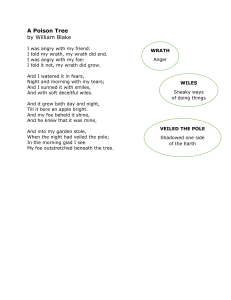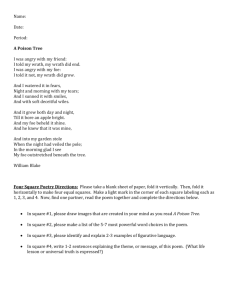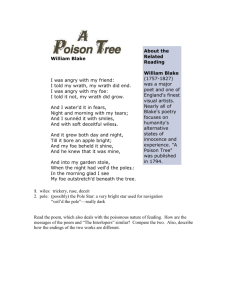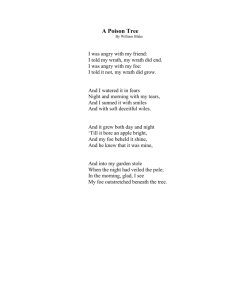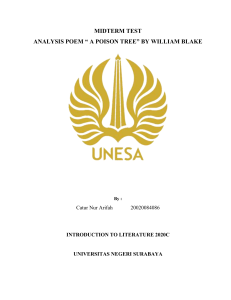Structure & Style Close Reading Lens
advertisement
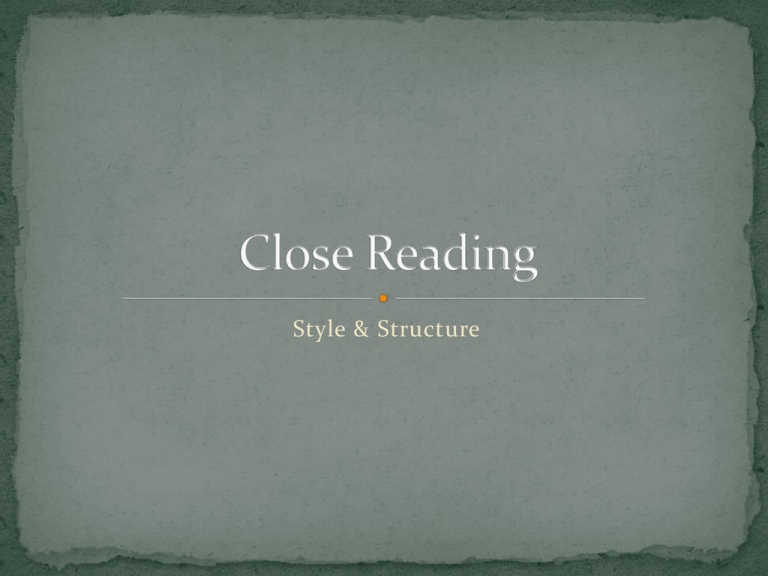
Style & Structure Take the poem “The Rose Through the Concrete” from my desk and read it carefully. In your notebook, consider the following and answer in complete sentences: What specific words jump out at you? What are the connotations of those words? What type of punctuation (or lack thereof) do you notice? How does the punctuation affect your understanding? Objective Agenda Students will examine Do Now how author choice concerning the style and structure of a text create such effects as drama, tension, or surprise. Note-Taking: Style and Structure Close reading Lens Practice: “The Poison Tree” by William Blake Exit Structure is the author’s organizational choice. Each genre has a different structure. Non-Fiction Poems Novels Short Stories What do the structures of these genre’s look like? STEP 1: Look for the author’s techniques: Descriptions Dialogue Flashbacks Comparisons/Contradictions Inner Thinking Repetition Patterns STEP 2: Describe the purpose of that organization/technique: To set the stage To reveal To create suspense To foreshadow STEP 3: Find patterns How are the parts similar? How are the parts different? What purpose do the parts serve? STEP 4: Use the patterns to develop a new understanding of the text. Look at patterns to think about: A character’s: Development A whole text’s: Themes Central Ideas Author’s purpose Writing style is the manner in which the author chooses to write to his audience. Each author has a unique style. The style of the author depends on the genre: Non-Fiction Poems Novels Short Stories STEP 1: Look for the author’s techniques: Sentence fluency (run-on or concise) Sentence Type Word choice (concise or descriptive) Voice (impersonal, chatty, authoritative, objective, or serious) Punctuation STEP 2: Describe the purpose of that style/technique: To set the stage To reveal To create suspense To foreshadow Structure & Style Lens I was angry with my friend; I told my wrath, my wrath did end. I was angry with my foe: I told it not, my wrath did grow. And I waterd it in fears, Night & morning with my tears: And I sunned it with smiles, And with soft deceitful wiles. And it grew both day and night. Till it bore an apple bright. And my foe beheld it shine, And he knew that it was mine. And into my garden stole, When the night had veild the pole; In the morning glad I see; My foe outstretched beneath the tree. Why do poets split their poems into multiple stanzas if the whole poem is focused on one topic? What is a stanza? Now let’s look at the poem’s organization/structure and how it influences its meaning. • What is this stanza about? I was angry with my friend; • What are the structure I told my wrath, my wrath did and style techniques you have noticed? end. I was angry with my foe: I told it not, my wrath did grow. The author states that he is extremely angry with his friend. Once, he told the friend he was angry, his anger disappeared. Then he was angry with an enemy but did not tell him and he became enraged. Techniques: inner-thinking, repetition, flashback, voice, and word choice. And I watered it in fears, Night & morning with my tears: And I sunned it with smiles, And with soft deceitful wiles. How does this stanza connect with the previous? Think in terms of structure and style. • What is this stanza about? • What are the structure and style techniques you have noticed? The author talks about his growing anger from his “fears” and “tears.” Then his mischievous thoughts grow with “smiles” and “wiles.” Techniques: inner-thinking, figurative language, metaphor, rhyme, and word choice. • What is this stanza about? What are the structure and style techniques you have noticed? And it grew both day and night. • Till it bore an apple bright. And my foe beheld it shine, And he knew that it was mine. How does this stanza connect with the previous? Think in terms of structure and style. As his anger grew, it produces a bright and shiny apple. The enemy finds the apple and realizes that it is the speakers. Techniques: inner-thinking, figurative language, voice, rhyme, and word choice. • What is this stanza And into my garden stole, about? When the night had veild the • What are the structure pole; and style techniques you In the morning glad I see; have noticed? My foe outstretched beneath the tree. The enemy tries to steal the How does this stanza connect with the previous? Think in terms of structure and style. speaker’s apple, which makes him a thief. This happens at night with the “pole” as the starts are covered. He ate the apple and died. Techniques: inner-thinking, figurative language, personification, voice, rhyme, and word choice. We read the poem stanza by stanza close reading for structure and style to make meaning. Answer the following questions on a piece of paper: Why would the author choose to structure the poem this way? Why would the author use these stylistic techniques? How does reading for Style & Structure impact the reader’s understanding of the text? HINT: Refer to Steps 2, 3, and 4 answer these questions. Independently, read through Langston Hughes’ poem “Mother to Son” and answer the questions that follow. MAKE SURE YOU ANSWER EACH QUESTION WITH 2-3 COMPLETE SENTENCES. Don’t forget about your participation rubrics.

